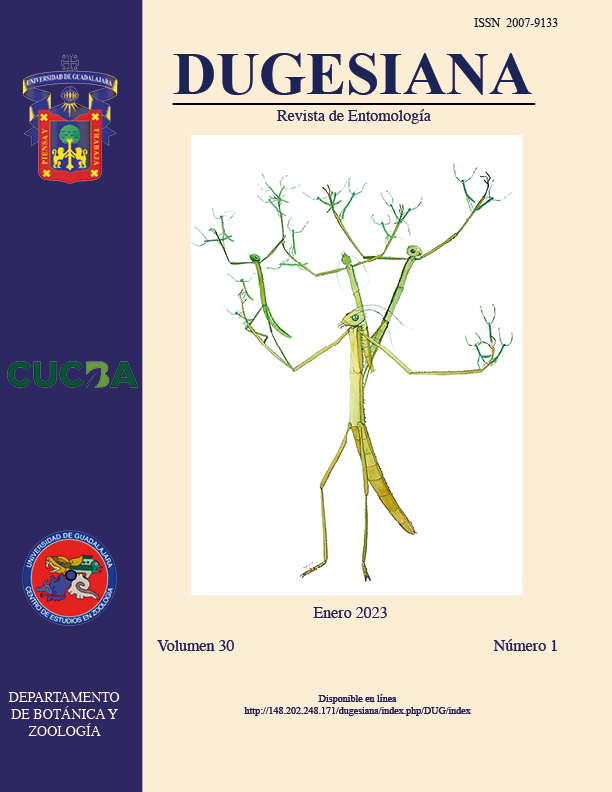𝑁𝑜𝑜𝑥𝑎𝑝𝑡𝑦 gen. nov. con dos especies nuevas (Phasmatodea: Diapheromeridae) de Oaxaca, México
DOI:
https://doi.org/10.32870/dugesiana.v30i1.7272Palavras-chave:
Diapheromerinae, Diapheromerini, Eusermyleformia, Phasmida, Pseudosermyle, Sermyleformia, Insectos palo, EscalosfríosResumo
Se describe Nooxapty gen. nov. y dos especies: Nooxapty isabelae sp. nov. y Nooxapty mixe sp. nov. para el norte de Oaxaca, México. Este género nuevo es colocado en la tribu Diapheromerini Kirby, 1904 y está relacionado con varias especies de Pseudosermyle Caudell, 1903. Nooxapty clavigerum comb. n. es cambiado de Pseudosermyle y colocado en Nooxapty gen. n., debido a que comparte sus caracteres principales.Referências
Bradler, S. 2009. Die Phylogenie der Stab- und Gespenstschrecken (Insecta: Phasmatodea). Species, Phylogeny and Evolution, 2 (1): 3–139.
Bragg, P. E. 1997. A glossary of terms used to describe phasmids. Phasmid Studies, 6 (1):24–33.
Bragg, P. E. 1998. A revision of the Heteropteryginae (Insecta:Phasmida: Bacillidae) of Borneo, with the description of a new genus and ten new species. Zoologische Verhandelingen, 316: 1–135.
Caudell, A. N. 1903. The Phasmidae or walkingsticks of the United States. Proceedings United States National Museum, 26 (1335): 863–885.
Clark Sellick, J. T. 1997. Descriptive terminology of the phasmid egg capsule, with an extended key to the genera based on egg structure. Systematic Entomology, 22 (2): 97–122. https://doi.org/10.1046/j.1365-3113.1997.d01-30.x
Clark Sellick, J. T. 1998. The micropylar plate of the eggs of Phasmida, with a survey of the range of plate form within the order. Systematic Entomology, 23 (3): 203–228. https://doi.org/10.1046/j.1365-3113.1998.00056.x
Conle, O. V., F. H. Hennemann and Y. Gutiérrez. 2011. The Stick Insects (Phasmatodea) of Colombia: A catalogue and bibliography with the descriptions of four new genera and 74 new species. Books on Demand GmbH, Norderstedt,Germany. https://doi.org/10.11646/zootaxa.1496.1.2
Conle, O. V., F. H. Hennemann and P. Fontana. 2007. Studies on Neotropical Phasmatodea V: notes on certain species of Pseudosermyle Caudell, 1903, with the descriptions of three new species from Mexico (Phasmatodea: Diapheromeridae:Diapheromerinae: Diapheromerini). Zootaxa, (1496): 31–51.
Gray, G. R. 1835. Synopsis of the Species of Insects Belonging to the Family of Phasmidae. Longman, Rees, Orme, Brown, Green and Longman, London.
Grimaldi, D. and M. S. Engel. 2005. Evolution of the insects. Cambridge University Press New York.
Hennemann, F. H. and O. V. Conle. 2012. Studies on neotropical Phasmatodea XIII: the genus Paracalynda Zompro, 2001, with notes on Eusermyleformia Bradler, 2009 (Insecta:Phasmatodea: Diapheromerinae: Diapheromerini). Journal of Orthoptera Research, 21(1):57–64. http://www.jstor.org/stable/41759696
Hennemann, F. H., O. V. Conle, P. D. Brock and F. Seow-Choen. 2016. Revision of the Oriental subfamily
Heteropteryginae Kirby, 1896, with a re-arrangement of the family Heteropterygidae and the descriptions of five new species of Haaniella Kirby, 1904. Phasmatodea:Areolatae:Heteropterygidae). Zootaxa, (4159): 1–219. https://doi.org/10.11646/zootaxa.4159.1.1
López-Mora, U. y J. E. Llorente-Bousquets. 2018. Lista de especies y clave ilustrada de los géneros de Phasmatodea (Insecta) de México. Revista Mexicana de Biodiversidad,89 (1): 46–78. https://doi.org/10.22201/ib.20078706e.2018.1.2175
Morrone, J. J. 2006. Biogeographic areas and transition zones of Latin America and the Caribbean Islands based on panbiographic and cladistic analyses of the entomofauna.
Annual Review of Entomology, 51: 467–497. https://doi.org/10.1146/annurev.ento.50.071803.130447
Morrone, J. J. Escalante, T. y Rodríquez-Tapia, G. (2017). Mexican biogeographic provinces: Map and shapefiles. Zootaxa 4277 (2): 277–279. https://doi.org/10.11646/zootaxa.4277.2.8
Nichols, S. W. 1989. Torre-Bueno glossary of entomology (Revised edition). New York Entomological Society New York.
Rehn, J. A. G. and J. W. H. Rehn. 1938. The Orthoptera of the Philippine Islands, Part I: Phasmatidae: Obriminae. Proceedings of the Academy of Natural Sciences of Philadelphia, 90: 389–487.
Downloads
Publicado
Edição
Seção
Licença
1. Política propuesta para revistas que ofrecen acceso abierto
Aquellos autores/as que tengan publicaciones con esta revista, aceptan los términos siguientes:- Los autores/as conservarán sus derechos de autor y garantizarán a la revista el derecho de primera publicación de su obra, el cuál estará simultáneamente sujeto a la Licencia de reconocimiento de Creative Commons que permite a terceros compartir la obra siempre que se indique su autor y su primera publicación esta revista.
- Los autores/as podrán adoptar otros acuerdos de licencia no exclusiva de distribución de la versión de la obra publicada (p. ej.: depositarla en un archivo telemático institucional o publicarla en un volumen monográfico) siempre que se indique la publicación inicial en esta revista.
- Se permite y recomienda a los autores/as difundir su obra a través de Internet (p. ej.: en archivos telemáticos institucionales o en su página web) antes y durante el proceso de envío, lo cual puede producir intercambios interesantes y aumentar las citas de la obra publicada. (Véase El efecto del acceso abierto).
2. Política propuesta para revistas que ofrecen acceso abierto diferido
Aquellos autores/as que tengan publicaciones con esta revista, aceptan los términos siguientes:- Los autores/as conservarán sus derechos de autor y garantizarán a la revista el derecho de primera publicación de su obra [ESPECIFICAR PERIODO DE TIEMPO], el cuál estará simultáneamente sujeto a la Licencia de reconocimiento de Creative Commons que permite a terceros compartir la obra siempre que se indique su autor y su primera publicación esta revista.
- Los autores/as podrán adoptar otros acuerdos de licencia no exclusiva de distribución de la versión de la obra publicada (p. ej.: depositarla en un archivo telemático institucional o publicarla en un volumen monográfico) siempre que se indique la publicación inicial en esta revista.
- Se permite y recomienda a los autores/as difundir su obra a través de Internet (p. ej.: en archivos telemáticos institucionales o en su página web) antes y durante el proceso de envío, lo cual puede producir intercambios interesantes y aumentar las citas de la obra publicada. (Véase El efecto del acceso abierto).




